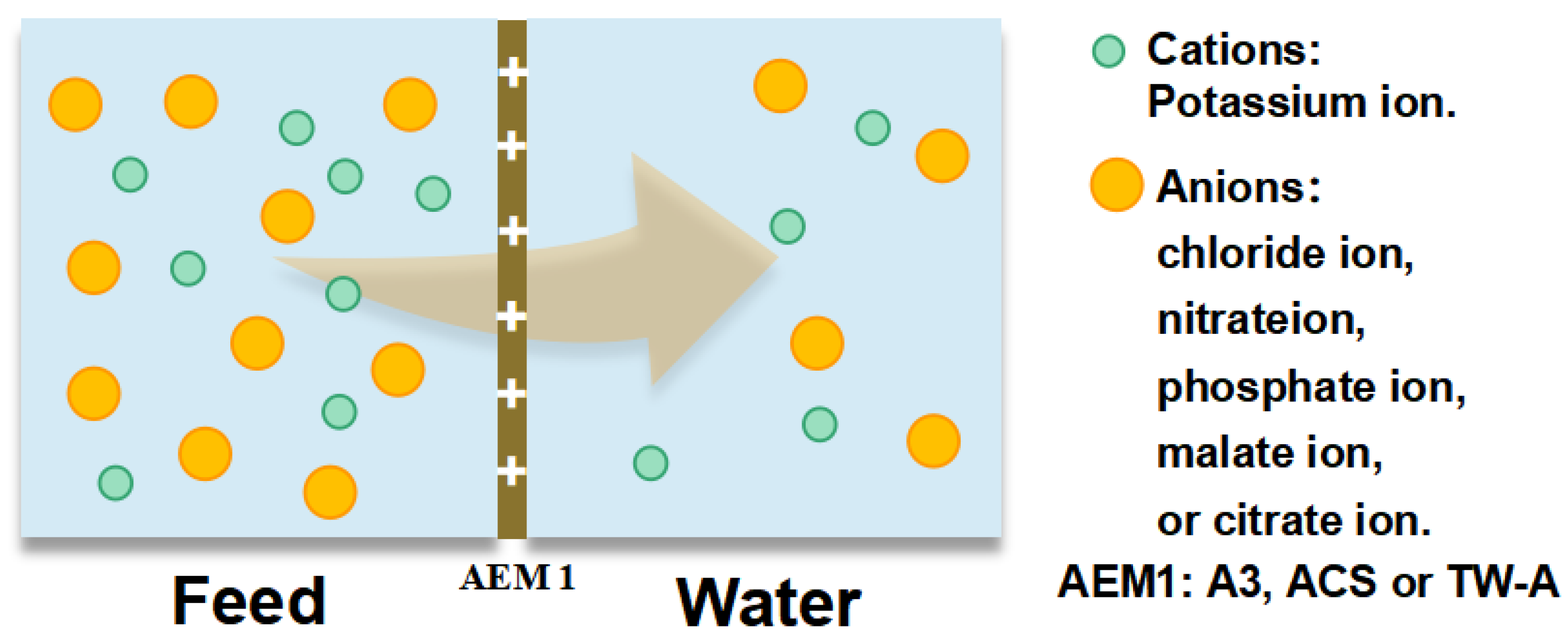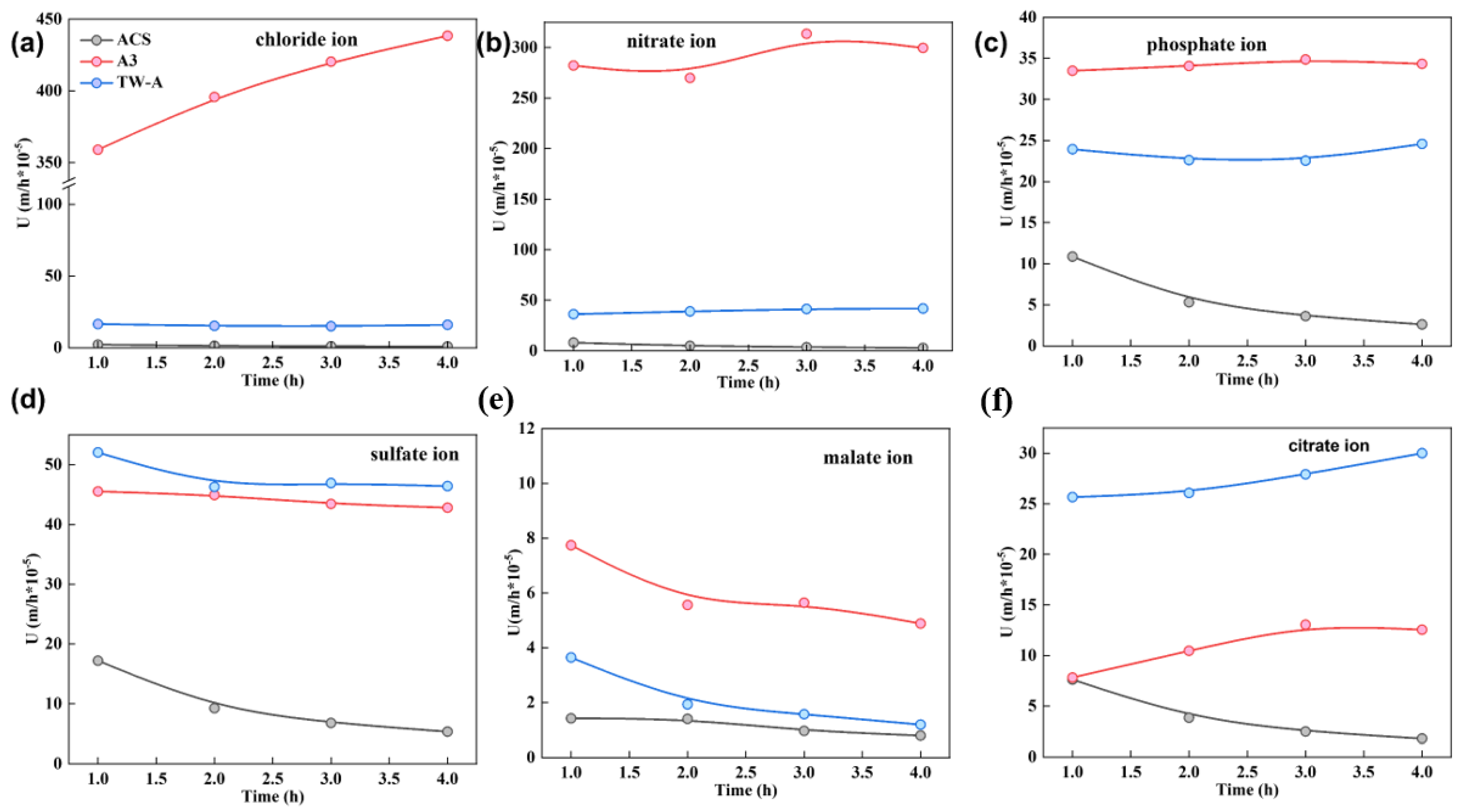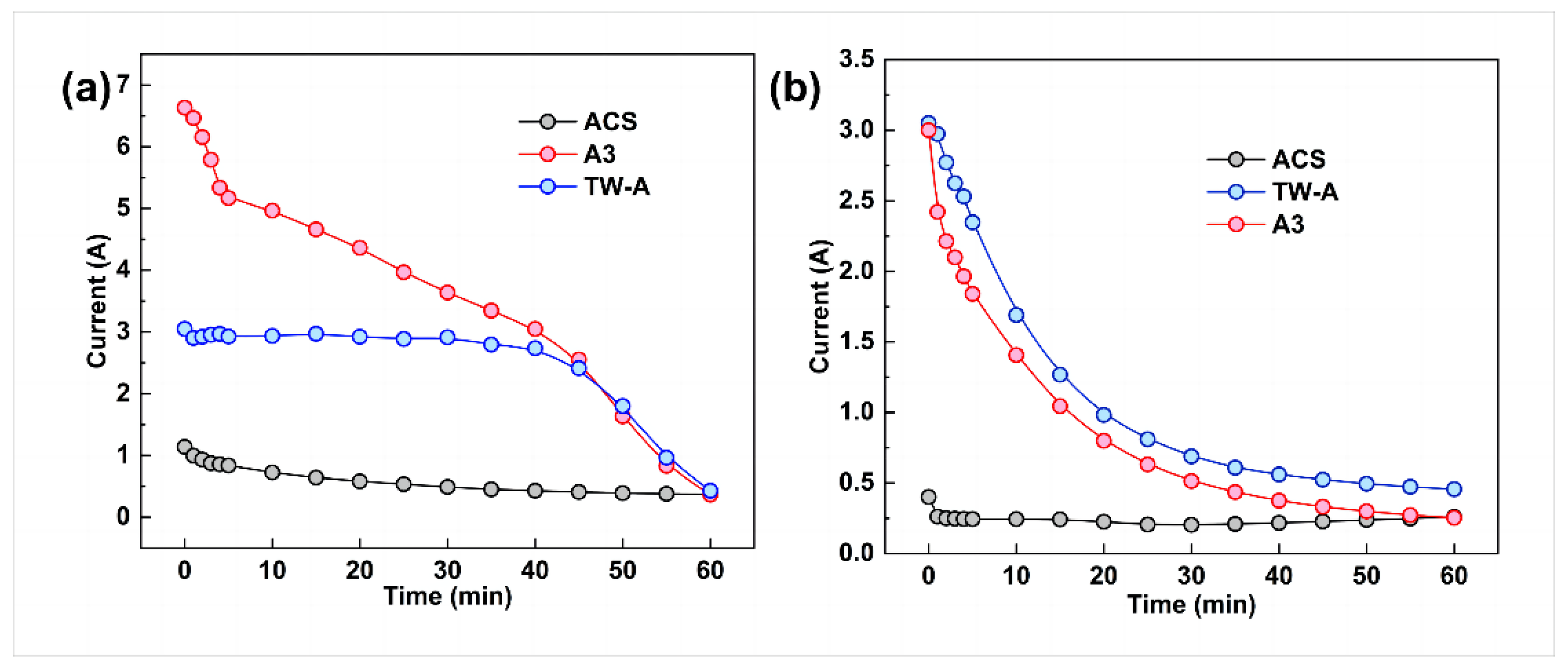Electrodialysis Metathesis (EDM) Desalination for the Effective Removal of Chloride and Nitrate from Tobacco Extract: The Effect of Membrane Type
Abstract
:1. Introduction
2. Experimental Section
2.1. Chemical and Materials
2.2. Experiment
3. Results and Discussion
4. Conclusions
Author Contributions
Funding
Institutional Review Board Statement
Data Availability Statement
Conflicts of Interest
Abbreviations
| EDM | Electrodialysis Metathesis |
| ED | Electrodialysis |
| DI | Deionized water |
| ACS | A type of anion exchange membrane from Astom Crop. Japan |
| A3 | A type of anion exchange membrane from Zhongke Xinyang Membrane Technology Co., Ltd. China |
| TW-A | A type of anion exchange membrane from Shandong Tianwei Membrane Technology Co., Ltd. China |
| AEM 1 | Anion exchange membrane located between a dilute room and a metathesis room |
| AEM 2 | Anion exchange membrane located between metathesis room and concentrated room |
| U | Permeation coefficient |
| Mi | Permeation molar quantity of ion i |
| A | Membrane area in diffusion experiment |
| t | Time in diffusion experiment |
| ΔC | Concentration difference between the feed side and waterside |
| J_i | Ion flux |
| D_i | Diffusion coefficient of ions i |
| Concentration gradient | |
| C2 | Ion concentration on the waterside |
| C1 | Ion concentration on the material side |
| l | The thickness of the membrane |
| zi | The valence of ion i |
| Ci | The concentration of ion i in the metathesis room |
| F | Faraday`s constant |
| R | Molar gas constant |
| T | Experiment temperature |
| Potential difference |
References
- Banožić, M.; Babić, J.; Jokić, S. Recent advances in extraction of bioactive compounds from tobacco industrial waste-a review. Ind. Crops Prod. 2020, 144, 112009. [Google Scholar] [CrossRef]
- Hu, T.-w.; Lee, A.H. Commentary: Tobacco control and tobacco farming in African countries. J. Public Health Policy 2015, 36, 41–51. [Google Scholar] [PubMed]
- Ge, S.; Li, W.; Zhang, Z.; Li, C.; Wang, Y. Desalting of tobacco extract using electrodialysis. Membr. Water Treat. 2016, 7, 341–353. [Google Scholar] [CrossRef]
- Commoner, B.; Lippincott, J.A.; Shearer, G.B.; Richman, E.E.; Wu, J.-H. Reconstitution of tobacco mosaic virus components. Nature 1956, 178, 767–771. [Google Scholar] [CrossRef] [PubMed]
- Gang, W.; Shuangshuang, W.; Huaicheng, Z.; Yichen, L.; Yiming, Z.; Wei, Z. Intelligent Prediction and Optimization of Extraction Process Parameters for Paper-Making Reconstituted Tobacco. In Proceedings of the International Conference on Bio-Inspired Computing: Theories and Applications, Qingdao, China, 23–25 October 2020; Springer: Singapore, 2020; pp. 60–68. [Google Scholar]
- Brown, J. Tobacco Marketing; United States Department of Agriculture, Economic Research Service: Washington, DC, USA, 1966.
- Zou, X.; Amrit, B.; Abu-Izneid, T.; Aziz, A.; Devnath, P.; Rauf, A.; Mitra, S.; Emran, T.B.; Mujawah, A.A.; Lorenzo, J.M. Current advances of functional phytochemicals in Nicotiana plant and related potential value of tobacco processing waste: A review. Biomed. Pharmacother. 2021, 143, 112191. [Google Scholar] [CrossRef]
- Marinello, S.; Lolli, F.; Gamberini, R.; Rimini, B. A second life for cigarette butts? A review of recycling solutions. J. Hazard. Mater. 2020, 384, 121245. [Google Scholar] [PubMed]
- Seyler, T.H.; Kim, J.G.; Hodgson, J.A.; Cowan, E.A.; Blount, B.C.; Wang, L. Quantitation of urinary volatile nitrosamines from exposure to tobacco smoke. J. Anal. Toxicol. 2013, 37, 195–202. [Google Scholar] [CrossRef]
- Svenningsson, B.; Rissler, J.; Swietlicki, E.; Mircea, M.; Bilde, M.; Facchini, M.; Decesari, S.; Fuzzi, S.; Zhou, J.; Mønster, J. Hygroscopic growth and critical supersaturations for mixed aerosol particles of inorganic and organic compounds of atmospheric relevance. Atmos. Chem. Phys. 2006, 6, 1937–1952. [Google Scholar] [CrossRef]
- Antin, T.M.J.; Hunt, G.; Annechino, R. Tobacco Harm Reduction as a Path to Restore Trust in Tobacco Control. Int. J. Environ. Res. Public Health 2021, 18, 5560. [Google Scholar] [CrossRef]
- Kniess, J. Tobacco and the Harms of Trade. J. Political Philos. 2018, 28, 296–306. [Google Scholar] [CrossRef]
- Parker, M.A.; Villanti, A.C.; Quisenberry, A.J.; Stanton, C.A.; Doogan, N.J.; Redner, R.; Gaalema, D.E.; Kurti, A.N.; Nighbor, T.; Roberts, M.E.; et al. Tobacco Product Harm Perceptions and New Use. Pediatrics 2018, 142, e20181505. [Google Scholar] [CrossRef] [PubMed]
- Baker, R.R.; Bishop, L.J. The pyrolysis of tobacco ingredients. J. Anal. Appl. Pyrolysis 2004, 71, 223–311. [Google Scholar] [CrossRef]
- Zhou, S.; Wang, C.; Xu, Y.; Hu, Y. The pyrolysis of cigarette paper under the conditions that simulate cigarette smouldering and puffing. J. Therm. Anal. Calorim. 2011, 104, 1097–1106. [Google Scholar] [CrossRef]
- Reisenauer, H.M.; Colwell, W.E. Some Factors Affecting the Absorption of Chlorine by Tobacco1. Soil Sci. Soc. Am. J. 1951, 15, 222–229. [Google Scholar] [CrossRef]
- Li, L.; Zhang, H.; Wen, J.; Shen, Y.; Li, D.; Luo, C.; Zheng, J.; Yang, J. Direct Determination of Free Nicotine Content in Tobacco. ACS Omega 2022, 7, 23061–23068. [Google Scholar] [CrossRef]
- Nie, J.; Yu, G.; Song, Z.; Wang, X.; Li, Z.; She, Y.; Lee, M. Microwave-assisted deep eutectic solvent extraction coupled with headspace solid-phase microextraction followed by GC-MS for the analysis of volatile compounds from tobacco†. Anal. Methods 2016, 9, 856–863. [Google Scholar] [CrossRef]
- Zeng, G.; Ran, Y.; Huang, X.; Li, Y.; Zhang, M.; Ding, H.; Ma, Y.; Ma, H.; Jin, L.; Sun, D. Optimization of Ultrasonic-Assisted Extraction of Chlorogenic Acid from Tobacco Waste. Int. J. Environ. Res. Public Health 2022, 19, 1555. [Google Scholar] [CrossRef]
- Bazinet, L.; Degrandpre, Y.; Porter, A. Enhanced tobacco polyphenol electromigration and impact on membrane integrity. J. Membr. Sci. 2005, 254, 111–118. [Google Scholar] [CrossRef]
- Bazinet, L.; DeGrandpré, Y.; Porter, A. Electromigration of tobacco polyphenols. Sep. Purif. Technol. 2005, 41, 101–107. [Google Scholar] [CrossRef]
- Ge, S.; Chen, Q.; Zhang, Z.; She, S.; Xu, B.; Liu, F.; Afsar, N.U. A Comprehensive Analysis of Inorganic Ions and Their Selective Removal from the Reconstituted Tobacco Extract Using Electrodialysis. Membranes 2022, 12, 597. [Google Scholar] [CrossRef]
- Ge, S.; Li, W.; Zhang, Z.; Li, C.; Wang, Y. A high-effective method to separate nicotine from the tobacco-specific carcinogen 4-(methylnitrosamino)-1-(3-pyridyl)-1-butanone (NNK) mixtures using electrodialysis. Membr. Water Treat. 2017, 8, 245–257. [Google Scholar] [CrossRef]
- Chen, Q.-B.; Ren, H.; Tian, Z.; Sun, L.; Wang, J. Conversion and pre-concentration of SWRO reject brine into high solubility liquid salts (HSLS) by using electrodialysis metathesis. Sep. Purif. Technol. 2019, 213, 587–598. [Google Scholar] [CrossRef]
- Shahid, M.K.; Kashif, A.; Fuwad, A.; Choi, Y. Current advances in treatment technologies for removal of emerging contaminants from water—A critical review. Coord. Chem. Rev. 2021, 442, 213993. [Google Scholar] [CrossRef]
- Zhang, Y.; Van der Bruggen, B.; Pinoy, L.; Meesschaert, B. Separation of nutrient ions and organic compounds from salts in RO concentrates by standard and monovalent selective ion-exchange membranes used in electrodialysis. J. Membr. Sci. 2009, 332, 104–112. [Google Scholar] [CrossRef]
- Rout, P.R.; Shahid, M.K.; Dash, R.R.; Bhunia, P.; Liu, D.; Varjani, S.; Zhang, T.C.; Surampalli, R.Y. Nutrient removal from domestic wastewater: A comprehensive review on conventional and advanced technologies. J. Environ. Manag. 2021, 296, 113246. [Google Scholar] [CrossRef]
- Zhang, W.; Miao, M.; Pan, J.; Sotto, A.; Shen, J.; Gao, C.; der Bruggen, B.V. Separation of divalent ions from seawater concentrate to enhance the purity of coarse salt by electrodialysis with monovalent-selective membranes. Desalination 2017, 411, 28–37. [Google Scholar] [CrossRef]
- Liu, R.; Wang, Y.; Wu, G.; Luo, J.; Wang, S. Development of a selective electrodialysis for nutrient recovery and desalination during secondary effluent treatment. Chem. Eng. J. 2017, 322, 224–233. [Google Scholar] [CrossRef]
- Camacho, L.M.; Fox, J.A.; Ajedegba, J.O. Optimization of electrodialysis metathesis (EDM) desalination using factorial design methodology. Desalination 2017, 403, 136–143. [Google Scholar] [CrossRef]
- Cappelle, M.; Walker, W.S.; Davis, T.A. Improving Desalination Recovery Using Zero Discharge Desalination (ZDD): A Process Model for Evaluating Technical Feasibility. Ind. Eng. Chem. Res. 2017, 56, 10448–10460. [Google Scholar] [CrossRef]








| Parameters | Variables | Other Conditions | |
|---|---|---|---|
| Membrane Type | AEM1 | AEM2 | Diluted chamber: 0.2 mol/L K3 Cit. Voltage: 7 V Flow velocity: 3 cm/s |
| ACS | A3 | ||
| TW-A | A3 | ||
| A3 | A3 | ||
| ACS | A3 | TW-A | |
|---|---|---|---|
| Cl− Removal rate (%) | 87.15 | 96.97 | 92.28 |
| NO3− Removal rate (%) | 90.39 | 96.11 | 99.28 |
| K+ Retention rate (%) | 14.51 | 77.12 | 42.17 |
| Cit3− Introduction rate (%) | -78.00 | 249.75 | 241.50 |
Disclaimer/Publisher’s Note: The statements, opinions and data contained in all publications are solely those of the individual author(s) and contributor(s) and not of MDPI and/or the editor(s). MDPI and/or the editor(s) disclaim responsibility for any injury to people or property resulting from any ideas, methods, instructions or products referred to in the content. |
© 2023 by the authors. Licensee MDPI, Basel, Switzerland. This article is an open access article distributed under the terms and conditions of the Creative Commons Attribution (CC BY) license (https://creativecommons.org/licenses/by/4.0/).
Share and Cite
Chen, Q.; Zhou, Y.; Ge, S.; Liang, G.; Afsar, N.U. Electrodialysis Metathesis (EDM) Desalination for the Effective Removal of Chloride and Nitrate from Tobacco Extract: The Effect of Membrane Type. Membranes 2023, 13, 214. https://doi.org/10.3390/membranes13020214
Chen Q, Zhou Y, Ge S, Liang G, Afsar NU. Electrodialysis Metathesis (EDM) Desalination for the Effective Removal of Chloride and Nitrate from Tobacco Extract: The Effect of Membrane Type. Membranes. 2023; 13(2):214. https://doi.org/10.3390/membranes13020214
Chicago/Turabian StyleChen, Qian, Yue Zhou, Shaolin Ge, Ge Liang, and Noor Ul Afsar. 2023. "Electrodialysis Metathesis (EDM) Desalination for the Effective Removal of Chloride and Nitrate from Tobacco Extract: The Effect of Membrane Type" Membranes 13, no. 2: 214. https://doi.org/10.3390/membranes13020214
APA StyleChen, Q., Zhou, Y., Ge, S., Liang, G., & Afsar, N. U. (2023). Electrodialysis Metathesis (EDM) Desalination for the Effective Removal of Chloride and Nitrate from Tobacco Extract: The Effect of Membrane Type. Membranes, 13(2), 214. https://doi.org/10.3390/membranes13020214







